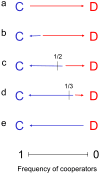Five rules for the evolution of cooperation
- PMID: 17158317
- PMCID: PMC3279745
- DOI: 10.1126/science.1133755
Five rules for the evolution of cooperation
Abstract
Cooperation is needed for evolution to construct new levels of organization. Genomes, cells, multicellular organisms, social insects, and human society are all based on cooperation. Cooperation means that selfish replicators forgo some of their reproductive potential to help one another. But natural selection implies competition and therefore opposes cooperation unless a specific mechanism is at work. Here I discuss five mechanisms for the evolution of cooperation: kin selection, direct reciprocity, indirect reciprocity, network reciprocity, and group selection. For each mechanism, a simple rule is derived that specifies whether natural selection can lead to cooperation.
Figures



References
-
- Hamilton WD. J Theor Biol. 1964;7:1. - PubMed
-
- Grafen A. In: Oxford Surveys in Evolutionary Biology. Dawkins R, Ridley M, editors. Vol. 2. Oxford University Press; Oxford: 1985. pp. 28–89.
-
- Taylor PD. Evol Ecol. 1992;6:352.
-
- Queller DC. Am Nat. 1992;139:540.
-
- Frank SA. Foundations of Social Evolution. Princeton Univ. Press; Princeton, NJ: 1998.
Publication types
MeSH terms
Grants and funding
LinkOut - more resources
Full Text Sources
Other Literature Sources

